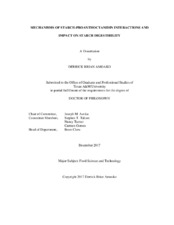| dc.description.abstract | Excess calorie intake is a growing global problem, and can be managed by impacting satiety and the rate of starch digestion in the small intestine. Proanthocyanidins (PA) are known to interact with amylose in cooked starch to increase resistant starch (RS). There is therefore an opportunity to utilize PA to directly reduce starch digestibility. The aim of this study was to investigate the effect of complexing partially gelatinized starch with PA on in-vitro starch digestibility, as well as to evaluate the interaction mechanisms involved in the complex formation. We also investigated potential intra-granular cross-linking of starch by PA.
Starch-PA complexes were formed by incubating PA extract with normal and waxy maize starch in 30% (30E) and 50% (50E) ethanol solutions at 70 °C / 20 min. The complexes were reacted with 6M urea and 15% aqueous dioxane to evaluate the contribution of H-bonding and hydrophobic interactions to starch-PA complexes, respectively. Treatments were analyzed for in-vitro digestibility and starch physicochemical properties. Cross-linked starches were formed with PA and phosphoryl chloride (POCl₃), and the effect on starch pasting properties evaluated.
In the 30E treatments, PA significantly increased crystallinity, pasting temperature, peak viscosity, and slow digesting starch (SDS) (from 100 to 274 mg/g) in normal starch. PA doubled RS to approximately 300 mg/g in both waxy and normal starches. In 50E treatments, PA made both maize starches behave like raw potato starch (>90% RS).
In 30E treatments, urea reduced RS by 39% and increased rapidly digestible starch (RDS) by 92% in normal maize-PA complexes, while freeing ~100% of PA bound in complex, suggesting H-bonds stabilize starch-PA complex in gelatinized starch. In 50E, dioxane released more PA (39-42%) bound in the complex than urea (25- 31%). Furthermore, restricting H-bond formation during starch-PA complexation with deuterated solvents, did not significantly affect starch digestibility, suggesting hydrophobic interactions stabilize starch-PA complexes in intact starch granules. PA formed V-type complexes with amylose. PA acted synergistically with POCl₃ to form heat resistant cross-linked starch.
Our findings suggest PA can be used as ingredients to reduce the caloric impact of starch in foods, and improve the functionality of cross-linked starches. | en |


